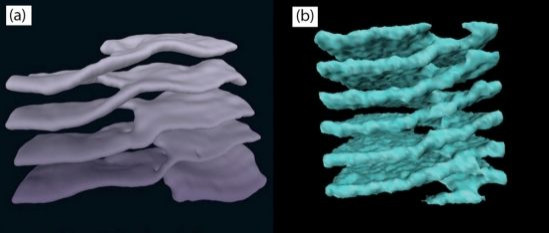Neutron Stars And Human Cells Have A Striking Similarity — Structures Resembling ‘Parking Garages’

What do neutron stars and human cells have in common, other than the fact they are both made of the same atoms? According to a new study published in the journal Physical Review C, structures resembling multi-storey parking garages.
“Seeing very similar shapes in such strikingly different systems suggests that the energy of a system may depend on its shape in a simple and universal way,” study co-author Charles Horowitz from Indiana University said in a statement released Tuesday.
In eukaryotic cells, such structures consisting of evenly spaced stacked sheets connected by helical ramps are found in the endoplasmic reticulum — a network of membranes connected to the nucleus, spread throughout the cytoplasm. In 2014, when researchers studied these structures in detail, they named them “Terasaki ramps” after their discoverer Mark Terasaki — a cell biologist at the University of Connecticut.
It turns out that similar structures, known to astrophysicists as “nuclear pasta,” are also observed when researchers try to create detailed computer simulations of neutron stars — which are dense corpses of stars.
“They see a variety of shapes that we see in the cell,” co-author Greg Huber, a condensed-matter physicist at the University of California, Santa Barbara, said in the statement. “We see a tubular network; we see parallel sheets. We see sheets connected to each other through topological defects we call Terasaki ramps. So the parallels are pretty deep.”
Despite the similarity, however, there are some key differences between Terasaki ramps and the pasta-like structures found deep within neutron stars, the most important one being the difference in scale. While in the neutron stars, these structures are based on protons and neutrons, which exist in the scale of femtometers, the structures found in cells can be measured in the scale of nanometers — a difference of a factor of a million.
“For neutron stars, the strong nuclear force and the electromagnetic force create what is fundamentally a quantum-mechanical problem. In the interior of cells, the forces that hold together membranes are fundamentally entropic and have to do with the minimization of the overall free energy of the system,” Huber explained. “This means that there is some deep thing we don’t understand about how to model the nuclear system.”
So what creates baffling geometric similarity between two objects that, at first glance, couldn’t be more different?
The answer, at least for now, is we don’t know.
“Our paper is not the end of something,” Huber said. “It's really the beginning of looking at these two models.”
© Copyright IBTimes 2025. All rights reserved.






















